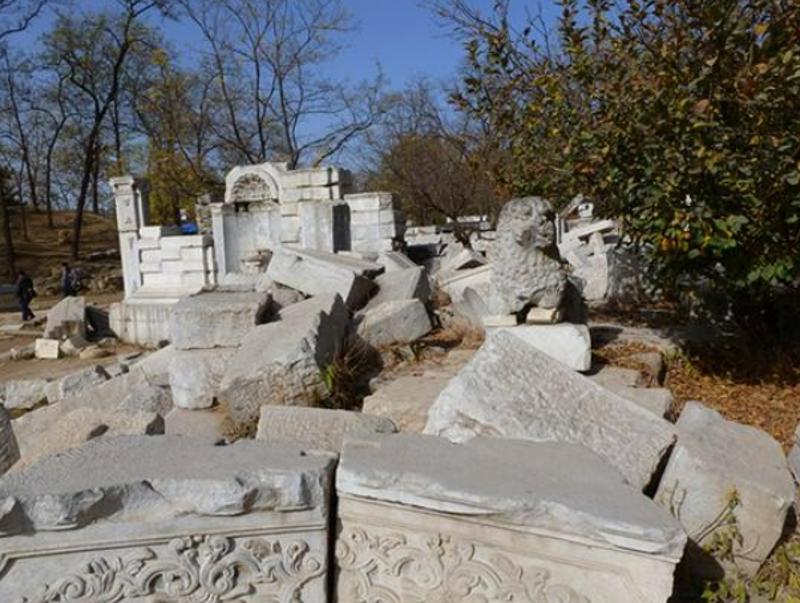Who destroyed the Old Summer Palace?
The Old Summer Palace was jointly destroyed by the Anglo-French Allied Forces and later by the Eight-Nation Alliance. Here is the detailed historical background and information about the destruction of the Old Summer Palace:

I. Devastating Acts by the Anglo-French Allied Forces
- Timing and Context: In 1860, the Anglo-French Allied Forces captured Beijing and occupied the Old Summer Palace.
- Process of Destruction: On October 18, 1860, James Bruce, the 8th Earl of Elgin and commander of the British forces, ordered the burning of the Old Summer Palace. The fire lasted for three days until October 21, 1860, during which the main buildings and a large number of precious cultural artifacts were destroyed.
- Plundering: Before setting fire to the Old Summer Palace, the Anglo-French Allied Forces conducted extensive looting, plundering the palace of its treasures.
II. Further Destruction by the Eight-Nation Alliance
- Timing and Context: In 1900, during the invasion of Beijing by the Eight-Nation Alliance, the Old Summer Palace suffered further damage.
- Destructive Acts: Once again, the Old Summer Palace was looted by the Eight-Nation Alliance, and with the support of the British Prime Minister, Lord Salisbury, it was ordered to be burned down by Lord Elgin. Additionally, trees were cut down, and pillars from bridges and palaces were removed, causing further destruction to the Old Summer Palace.
III. Other Contributing Forces to the Destruction
In addition to the Anglo-French Allied Forces and the Eight-Nation Alliance, some Chinese individuals played a role in the destruction of the Old Summer Palace. These included individuals labeled as "traitorous elements" by the Qing government, who collaborated with the aggressors, participating in looting and burning the Old Summer Palace. Furthermore, in the decades that followed, many people entered the Old Summer Palace and excavated the grounds in search of scattered treasures, exacerbating the extent of the destruction.
IV. Current State and Significance of the Old Summer Palace
Today, the Old Summer Palace has become an important historical site, attracting countless visitors. Although it has lost its former splendor, it remains an outstanding representative of ancient Chinese imperial gardens and an important chapter in Chinese national history. The destruction of the Old Summer Palace was a tremendous tragedy in Chinese history, reminding us to remember history, cherish peace, and collectively safeguard humanity's cultural heritage.
V. Impact and Consequences of the Destruction
- Cultural Loss: The destruction of the Old Summer Palace led to the loss of precious Chinese cultural heritage. Many valuable artworks, ancient books, and cultural relics turned to ashes in the fire, irretrievably damaging China's cultural heritage and historical memory.
- Psychological Trauma: The destruction of the Old Summer Palace not only brought immense material loss to the Chinese people but also left deep psychological scars. For the Chinese, the Old Summer Palace was not just a garden but also a symbol of Chinese civilization and national dignity. Its destruction shocked the entire nation, dealing a heavy blow to the national pride and confidence.
- Reflection on National Revival: The destruction of the Old Summer Palace became a significant symbol in modern Chinese history, prompting reflections on national strength and the revival of the Chinese nation. This event spurred the Chinese people's desire for national independence, prosperity, and the well-being of the people, becoming an important source of patriotism in modern Chinese history.
VI. Efforts in Protection and Reconstruction
- Cultural Heritage Protection: Since the 20th century, the Chinese government has implemented a series of measures to protect the site and artifacts of the Old Summer Palace. These include strengthened supervision and security measures, restoration of damaged buildings, and scientific archaeological research at the site.
- Heritage Memory Inheritance: Through exhibitions, publications, lectures, and other forms, Chinese society actively promotes the inheritance and dissemination of the historical memory of the destruction of the Old Summer Palace. This helps to raise awareness and importance of cultural protection among the public.
- Cultural Renaissance: The protection and reconstruction of the Old Summer Palace have become part of China's cultural renaissance. By drawing on ancient architectural techniques, exploring the value of cultural relics, and promoting traditional cultural spirits, China strives to rebuild the Old Summer Palace into a cultural heritage conservation area with modern significance.
The above is a detailed historical background and information about the destruction of the Old Summer Palace. For more information, it is recommended to consult relevant historical documents or historians.